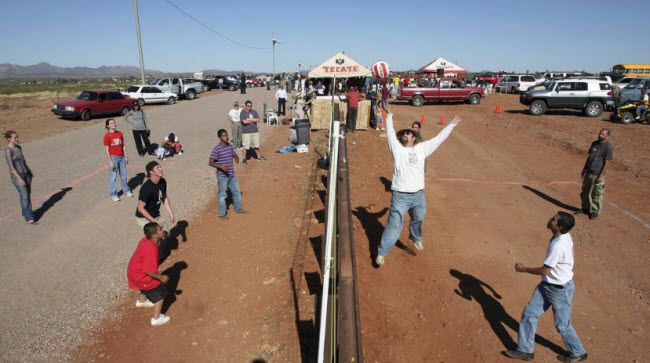Volleyball is one of the most popular team sports globally and a key event in the Olympic Games. Its popularity has led to variations, such as beach volleyball. But could this game serve as a bridge to connect two towns with a shared history but belonging to different countries? While it might seem like an unusual idea, the answer can be found on the U.S.-Mexico border. For about 30 years, residents of a small border town called Naco, split between the two countries, have played volleyball over the border fence—a symbolic gesture of unity between the towns despite their political and geographical differences.
From 1979 to 2007, the residents of Naco in Sonora, Mexico, and Naco in Arizona, USA, held an annual volleyball game over the barbed-wire fence, under the watchful eyes of border patrols from both countries. The locals report that there were never any tensions during these matches. The games were supervised by officials from both towns, and the only challenges were minor. One problem was that the barbed wire would puncture the volleyballs, so players covered them with a rubber cloth. The other issue was that the team losing three out of five matches had to host the winning team. Due to the border fence, they created an opening to allow the Mexican side, which usually won, to attend the celebration on the American side.

This game, known as “Fiesta by Nacional” or sometimes “Wallyball,” aimed to foster positive relations between Mexico and the United States despite ongoing tensions over immigration and other issues. It proved successful and inspired similar events along the border. For instance, beachgoers in San Diego, California, and Tijuana, Mexico, would engage in impromptu volleyball games on the sandy beaches where the two countries meet at the Pacific Ocean.

Historians regard this game as a significant event that united the two towns, which were once a single community celebrating national holidays together. However, as immigration laws and conditions changed, so did the nature of these cross-border matches. Previously, there was a simple fence marking the northern and southern borders with a gap widely known as “El Hoyo” (The Hole in Spanish). Residents would crawl through to buy food or cross for celebrations. This changed in 1994 when President Bill Clinton’s administration enforced stricter border controls by deploying more U.S. Border Patrol agents and National Guard troops. By the late 1990s, the barbed-wire fence was replaced with large metal barriers welded together, closing nearly 500 kilometers of the 580-kilometer border sector in Naco. As a result, residents had to move their volleyball games and parties to areas where the ball could still cross over the fence.

Due to the unique nature and location of this game, it attracted media coverage. In April 2007, residents from both sides gathered to mark a volleyball court on the orange, dusty ground with pink chalk and attempted to keep the ball from hitting the ground. This match was the last of its kind due to the now higher and impassable fence. Nevertheless, friends from both sides still meet to chat and reminisce about the old days when their biggest concern was the barbed wire that could puncture the ball.
